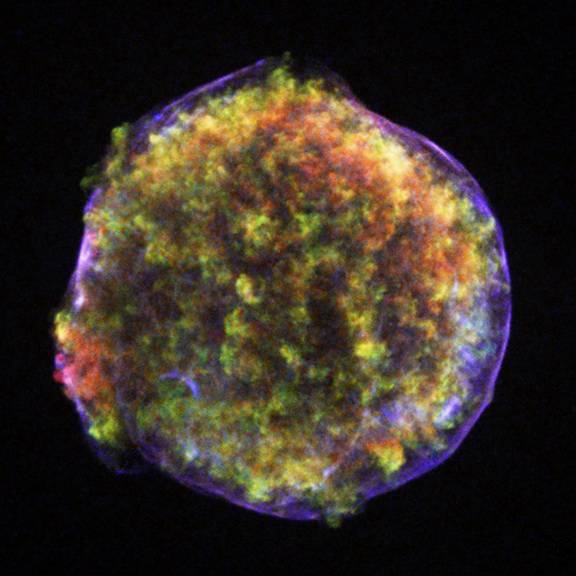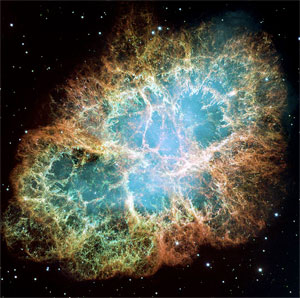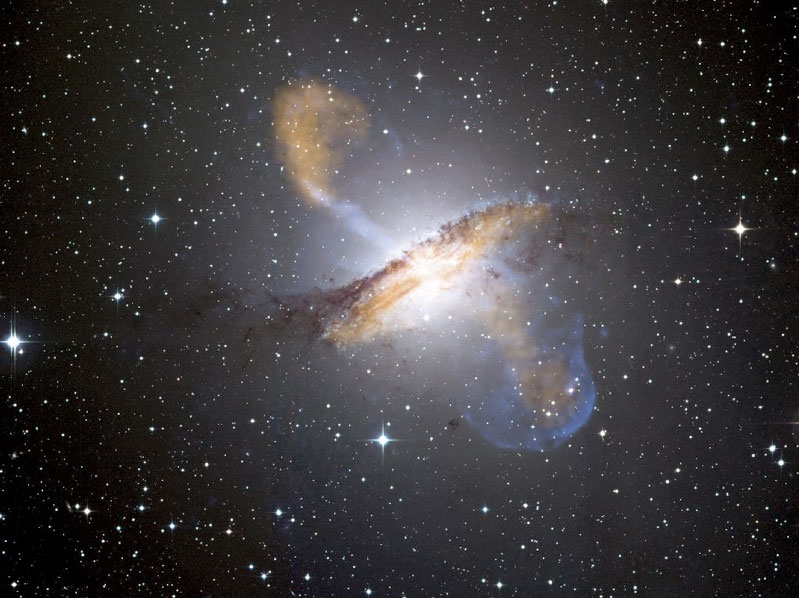Supernova Remnants
 After the explosion of a star (a "supernova", SN), the evolution of the stellar debris and its interaction with the surroundings gives rise to a number of fascinating phenomena. When talking of Supernova Remnants (SNRs), here we will refer to the nebular remnants that originate from the impact of the stellar matter (the "ejecta", hurled at high speed) against the ambient medium. The emission from these objects usually presents a limb-brightened morphology (where the interaction takes place) and are then referred to as "shell-type SNRs". In objects with an inner active pulsar, nebular remnants are also produced by the interaction of the pulsar relativistic wind with the surrounding SN ejecta. They are known as "pulsar wind nebulae" (PWNe), and are described in a separate section. The expansion of a SNR may last about one million years, before it eventually merges into the interstellar medium (ISM) and disappears. However, since older SNRs are also fainter and difficult to identify, the ages of known SNRs are shorter, typically around 10000-100000 yr. The evolution of a SNR can be subdivided into a few phases:
After the explosion of a star (a "supernova", SN), the evolution of the stellar debris and its interaction with the surroundings gives rise to a number of fascinating phenomena. When talking of Supernova Remnants (SNRs), here we will refer to the nebular remnants that originate from the impact of the stellar matter (the "ejecta", hurled at high speed) against the ambient medium. The emission from these objects usually presents a limb-brightened morphology (where the interaction takes place) and are then referred to as "shell-type SNRs". In objects with an inner active pulsar, nebular remnants are also produced by the interaction of the pulsar relativistic wind with the surrounding SN ejecta. They are known as "pulsar wind nebulae" (PWNe), and are described in a separate section. The expansion of a SNR may last about one million years, before it eventually merges into the interstellar medium (ISM) and disappears. However, since older SNRs are also fainter and difficult to identify, the ages of known SNRs are shorter, typically around 10000-100000 yr. The evolution of a SNR can be subdivided into a few phases:
- A very early phase (lasting a few tens of years) in which the SN blast wave hits the closest, and densest, circumstellar medium (CSM), expelled by the SN progenitor during the last 1000-10000 years of its live. In this phase the object is not considered a SNR as yet.
- An early phase (also named as "ejecta-dominated phase"), in which the ejecta move into more tenuous CSM or in the ISM, while the amount of swept up matter is still not enough to decelerate effectively the bulk of the ejecta. Right behind the main shock (also called "forward shock"), which moves through the ambient medium at typical speeds of 3,000-6,000 km/s, a secondary shock forms (the so-called "reverse shock"), which will eventually propagate back into the ejecta. This phase will last until the forward shock has collected from the ambient medium a mass comparable with that of the SN: for a "typical" SNR it may take about 1000 yr.
- When the mass of the swept up medium becomes dominant and keeps increasing, the forward shock slows down considerably, even if the total SNR energy keeps roughly constant (this is why this phase is dubbed as "adiabatic phase"). During the transient to this phase, the reverse shock detaches from the forward one, propagates through the SN ejecta until it reaches the centre, and the SNR volume is crossed by secondary shocks moving in all directions. But, eventually, the radial profiles of the various hydrodynamic quantities will approach a universal profile, known as Sedov-Taylor solution. Memory is kept only of the energy of the SN explosion.
- The velocity of the SNR shock further decreases with time and, with it, also the temperature of the shocked medium. When it goes below a few 100000 degrees, the efficiency of the plasma thermal cooling grows up considerably, and the SNR enters in the so-called "radiative phase". This may happen at typical ages of a few 10000 yr, depending on the ISM density. While a more representative quantity for this transition is its shock velocity, which is always around 300-400 km/s, for a rather wide range of ambient conditions.
- The radiative phase represents the final stage of the SNR life. The blast wave then gradually loses its strength, eventually downgrading to a sonic wave, and the SNR merges into the ISM.
 There are two main limitations to the "classical" evolution of the SNRs, as outlined above. On one side it does not consider the possibility of asymmetries in the SN explosion, while observations show that asymmetries are rather the rule than the exception. On the other side it does not include the effects of cosmic-ray (CR) acceleration, while if SNRs are the main source of Galactic CRs, at least up to about 100-1000 TeV (the position of the so-called CR spectral "knee"), a near 10% efficiency in CR acceleration would be required. A separate section is devoted to CRs, but some aspects and implications of particle acceleration in SNRs will be also discussed here. It has been theoretically shown how ions can enter the acceleration processes, and how (through diffusive acceleration, also known as 1st order Fermi acceleration) they can reach very high energies. The process is non linear: the CR streaming in front of the shock discontinuity may amplify turbulent magnetic fields in the upstream region, which in turn are responsible for effective scattering of particles, and their subsequent acceleration. This means that the relativistic particles are not passively accelerated, but contribute themselves to the structure and properties of the shock, giving rise to the so-called "CR-modified shock". A number of predictions follow, both on the observed structure (mostly in X-rays and Radio) of the shock, and on its hadronic gamma-ray emission. Actually, this is the only way to directly observe accelerated ions in SNRs: through their collisions with the ambient ions they create pions, which then decay emitting gamma-ray photons. Young SNRs, like Tycho's SNR, RX J1713.7-3946, SN 1006, are the best targets for this kind of investigation. The main difficulty lies in disentangling the origin of the gamma-ray emission, which can come from hadronic as well as from leptonic processes, namely Inverse Compton scattering of high energy electrons on the radiation background. Our group has put much effort in the detailed modeling of the multi-wavelength emission of a few of these remnants to the aim of clarifying
The physical conditions and processes in SNR shocks are, however, far from being assessed. For instance, our group has shown that, if a SNR shock moves through a partially neutral medium, a "neutral return flux" appears and can modify substantially the structure of the shock, with effects on the energy distribution of the accelerated particles. A very good diagnostics of this neutral component is provided by the so-called "non-radiative" Balmer emission, in optical. Combining information coming from observations in this optical line with measurements in the X-ray band will eventually allow us to constrain the structure of the shock, and its CR acceleration efficiency. While in terms of energy the acceleration of ions is the dominant process, electrons acceleration is the most relevant from a diagnostic point of view, since we can directly observe them through their non-thermal emission. SNRs are powerful non-thermal emitters, and in fact most of the Galactic SNRs have been discovered from their radio synchrotron emission. Unfortunately, even though there is a wealth of observational evidence that electrons are accelerated in SNR shocks, the theoretical modeling of their injection into the acceleration process has only recently started. Our group has deeply been involved in the study of the process efficiency from the observations’ point of view. There is indeed observational evidence that the efficiency in accelerating electrons is a smooth function of some global parameters of the SNR. This is proven by well-known correlations, starting from the so-called Sigma-D relation (an empirical relation between the SNR size and its surface brightness in radio) to more sophisticated statistical analyses that involve also the density of the ambient medium.
There are two main limitations to the "classical" evolution of the SNRs, as outlined above. On one side it does not consider the possibility of asymmetries in the SN explosion, while observations show that asymmetries are rather the rule than the exception. On the other side it does not include the effects of cosmic-ray (CR) acceleration, while if SNRs are the main source of Galactic CRs, at least up to about 100-1000 TeV (the position of the so-called CR spectral "knee"), a near 10% efficiency in CR acceleration would be required. A separate section is devoted to CRs, but some aspects and implications of particle acceleration in SNRs will be also discussed here. It has been theoretically shown how ions can enter the acceleration processes, and how (through diffusive acceleration, also known as 1st order Fermi acceleration) they can reach very high energies. The process is non linear: the CR streaming in front of the shock discontinuity may amplify turbulent magnetic fields in the upstream region, which in turn are responsible for effective scattering of particles, and their subsequent acceleration. This means that the relativistic particles are not passively accelerated, but contribute themselves to the structure and properties of the shock, giving rise to the so-called "CR-modified shock". A number of predictions follow, both on the observed structure (mostly in X-rays and Radio) of the shock, and on its hadronic gamma-ray emission. Actually, this is the only way to directly observe accelerated ions in SNRs: through their collisions with the ambient ions they create pions, which then decay emitting gamma-ray photons. Young SNRs, like Tycho's SNR, RX J1713.7-3946, SN 1006, are the best targets for this kind of investigation. The main difficulty lies in disentangling the origin of the gamma-ray emission, which can come from hadronic as well as from leptonic processes, namely Inverse Compton scattering of high energy electrons on the radiation background. Our group has put much effort in the detailed modeling of the multi-wavelength emission of a few of these remnants to the aim of clarifying
The physical conditions and processes in SNR shocks are, however, far from being assessed. For instance, our group has shown that, if a SNR shock moves through a partially neutral medium, a "neutral return flux" appears and can modify substantially the structure of the shock, with effects on the energy distribution of the accelerated particles. A very good diagnostics of this neutral component is provided by the so-called "non-radiative" Balmer emission, in optical. Combining information coming from observations in this optical line with measurements in the X-ray band will eventually allow us to constrain the structure of the shock, and its CR acceleration efficiency. While in terms of energy the acceleration of ions is the dominant process, electrons acceleration is the most relevant from a diagnostic point of view, since we can directly observe them through their non-thermal emission. SNRs are powerful non-thermal emitters, and in fact most of the Galactic SNRs have been discovered from their radio synchrotron emission. Unfortunately, even though there is a wealth of observational evidence that electrons are accelerated in SNR shocks, the theoretical modeling of their injection into the acceleration process has only recently started. Our group has deeply been involved in the study of the process efficiency from the observations’ point of view. There is indeed observational evidence that the efficiency in accelerating electrons is a smooth function of some global parameters of the SNR. This is proven by well-known correlations, starting from the so-called Sigma-D relation (an empirical relation between the SNR size and its surface brightness in radio) to more sophisticated statistical analyses that involve also the density of the ambient medium.

 Arcetri High Energy Group
Arcetri High Energy Group 